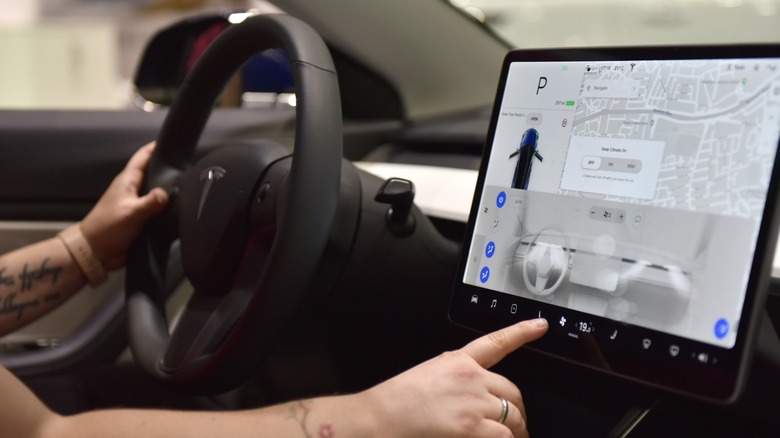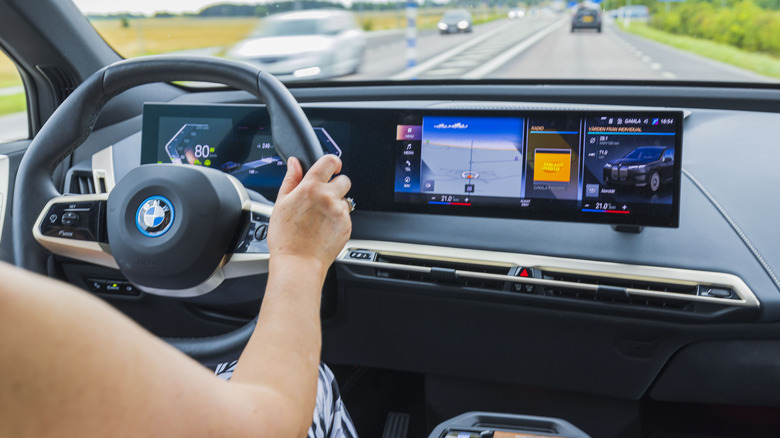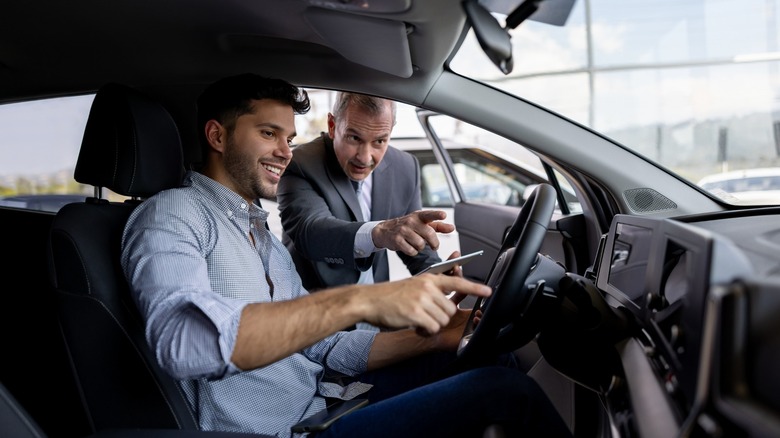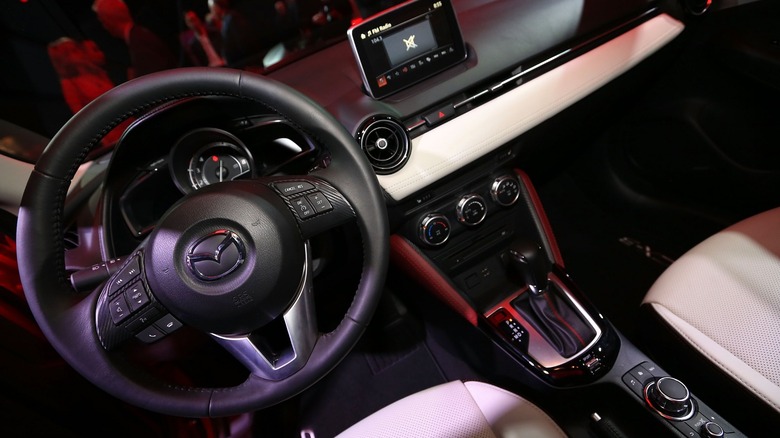Are More Screens And Fewer Buttons In Cars Really That Safe?
If you bought a brand-new car just 10 years ago, you'd have gotten a vehicle with many buttons, dials, and even a couple of stalks across the dashboard. If you have a more premium car, you might've even received a nice little touchscreen infotainment system. Even so, some brands like BMW and Mazda have a dial that lets you control the screen without touching it.
However, if you look at cars today, many models are now eschewing physical buttons for several smaller screens, or one massive touch display. Tesla led the way in this trend, starting with the 2012 Model S, which featured a 12.3-inch digital dash and a 17-inch central control panel — and continuing today with the 2024 Model 3, which has everything on the 15.3-inch central touchscreen display.
Other brands have followed suit in this trend, like the 2022 Mercedes-AMG EQS, the BMW i4 M50, and the 2023 Ford Mustang Mach-E, which all feature massive touch screens instead of physical buttons and controls. But are touchscreens safe for the motoring public? Many automakers have made the case for — and against — the use of touchscreens versus knobs/buttons when it comes to infotainment or climate controls.
Why automakers put touchscreens in cars
As smartphones and tablet touchscreens developed, automakers added them to vehicles as well. This is especially true as iPhones and Android phones have become versatile driving tools. Infotainment screens have accurate mapping and directional functions, versatile music players, and can deliver real-time traffic reports. Incorporating a large touchscreen eliminates the need to look at a small screen to go to the next track or to check how far your next exit is.
However, there's a bigger financial reason carmakers put touchscreens in cars — they're cheaper. According to car reviewer Matt Farah of Slate, "These screens are presented as this avant-garde, minimalist design ... But really, it's the cheapest way possible of building an interior."
While touchscreens may look more expensive over buttons and physical controls, the mere fact that you can use the same touchscreen model across different makes, models, and variants could save manufacturers millions of dollars in production costs. That's because the top-of-the-line model could use the same touchscreen display as the one on the base model car. All a carmaker has to do is change the programming to make the display on the high-end car look fresh and more premium.
It also saves on development costs as manufacturers don't have to make all-new buttons on newer models. They could just reuse the same display, thus making a new car interior much cheaper.
You need to take your eyes off the road
When larger touchscreens arrived in cars, many users were impressed with the tech. However, reality soon set in when people started driving them, with instances of many controls being buried deep in the infotainment system. To varying degrees, driving these cars has become more challenging when you need to look at the screen to find where things are.
Swedish automotive magazine Vi Bilägare even went so far as to perform an experiment, attempting to prove that vehicles with touchscreen controls were more challenging to operate. The outlet compared modern vehicles to a 2005 Volvo V70, which had no touchscreens. 11 modern cars were tested, with drivers instructed to do the following:
- Activate the heated seats, increase the temperature by two degrees, and start the defroster.
- Turn on the radio and tune it to Sweden's Program 1.
- Reset the trip computer, lower instrument lighting brightness to the lowest setting, and turn off the main display.
Drivers usually do these things while cruising along the freeway — you don't normally have to pull over to do them safely. Before the test, the drivers familiarized themselves with their chosen cars. They then drove at 110 kph — 68 mph — and performed the tasks while a passenger timed them.
The magazine then measured the time and distance covered upon finishing the tasks, and the results were not surprising. The 2005 Volvo V70 only traveled 306 meters for 10 seconds before the driver finished all tasks, while the Chinese EV 2024 MG Marvel R — which featured a colossal touchscreen display 56 degrees below the driver's line of sight — had the worst performance at nearly 44.9 seconds or 1.4 km.
While this does not exactly say that cars with touchscreen are unsafe, it shows how much longer a driver has to remove their focus from driving when manipulating inefficient touch controls.
Touchscreens, gestures, and voice control
Some would argue that the touchscreen is just a stepping stone towards gesture and voice control. While this may look safer than physical buttons and touch displays on paper, that is not really the case. In fact, we've talked about how gesture controls could make things harder on tech as far back as 2018.
While we're used to using gestures on our smartphones today, we still have to keep our eyes on the screen to ensure that our gestures work as intended. So, even if you use hand gestures in your car, you'd still have to look down to see if they worked, or perhaps why they didn't.
Another argument is that voice control would make it safer to operate touchscreens while driving. But voice control hasn't been perfected even with more advanced AI technologies. Ars Technica even reported on a study that voice-activated infotainment systems are still distracting, even more distracting than talking on the phone to something like Siri.
Even if gestures and voice control worked perfectly 100% of the time (they don't), many drivers find these features distracting. And when they don't work as intended, drivers will get frustrated and even more distracted as they attempt to troubleshoot why the infotainment system refuses to act on the gesture or voice commands they give.
No, touchscreens aren't safer than buttons
While many carmakers keep adding larger touch displays to cars, several researchers have continuously found that these systems make driving more dangerous. The U.K.'s Transport Research Laboratory, along with IAM RoadSmart, have found that using touchscreens while driving impairs the driver almost five times more than driving at the drink-drive limit in England, Wales, and Northern Ireland.
Even VNC Automotive, a transportation telematics company, questioned the prevalence of touchscreens in our cars. According to CEO Tom Blackie, "Competition for driver attention has never been greater. The roads are busier than ever, touchscreens dominate vehicle interiors, and we're living increasingly connected lives. That means there are now many more opportunities for a driver's focus to be elsewhere."
He further adds, "Our experience gained as a result of having our technology installed in 35 million vehicles worldwide has shown us that there's a subtle yet significant difference between an interface that offers a slick window onto a digital world and one that buries basic functionality at the centre of a labyrinth."
Because of these findings, the Euro NCAP is instituting new rules that require cars to have physical controls for the following functions to get a five-star rating: turn signals, hazard lights, horn, windscreen wipers, and the eCall SOS activation.
There's a place for touchscreens and physical controls
While placing crucial functions deep inside touchscreen menus is unsafe, these large displays still have a place in modern cars. However, they should not replace physical buttons for vehicle features that drivers frequently use. While the Euro NCAP is on the right track by requiring these basic safety features to have physical controls, expanding the requirement might be necessary.
Drivers frequently change climate control settings, the sound volume, and the current track or radio station while on the road. Having these controls as tactile buttons makes sense so the driver can make their changes without looking away from the windshield. Since we can feel and hear the changes we make to the climate and sound system, we don't have to look at them when making adjustments.
Nevertheless, a touchscreen is still crucial to modern cars, especially as we can use it for navigation and to adjust the vehicle when parked. However, it should not take center stage, as driving should always take priority when you're on the road. This is also why many planes, especially airliners, have tons of buttons and physical controls in the cockpit. That's because pilots must react in a split-second if anything untoward happens. With a physical button, they can instinctively reach and control the plane without looking — something they cannot do with a touchscreen. The same mantra applies to drivers on the road as well.






